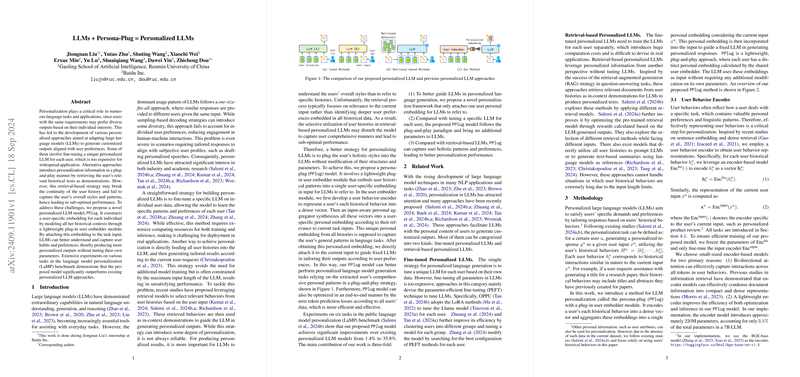The paper "LLMs + Persona-Plug = Personalized LLMs" explores a novel approach to personalizing LLMs through a technique referred to as the Persona-Plug (PPlug) model. This method aims to enhance the ability of LLMs to produce outputs tailored to individual user preferences without requiring extensive fine-tuning of the LLMs themselves.
Background and Motivation
Personalization in natural language processing is imperative for tailoring responses to the specific preferences and contexts of users. Traditional personalization methods often involve creating a personalized LLM for each user through fine-tuning, which is computationally costly and impractical for large-scale applications. An alternative approach involves using retrieval-based methods, which employ user history as demonstrations. However, these methods fail to capture the holistic behavior and preferences of users over time, leading to sub-optimal personalization performance.
Methodology
The PPlug model addresses these challenges through the following components:
- User Behavior Encoder: This module encodes each historical behavior of the user into dense vector representations using an encoder-based model. Notably, a different encoder processes the current input from the user.
- Input-Aware Personal Aggregator: This component aggregates the encoded historical vectors into a singular personal embedding. The key here is the input-aware nature of the aggregation process, which dynamically assigns weights to each historical behavior based on its relevance to the current task input.
- Persona-Plug for LLM Personalization: Once the personal embedding is aggregated, it is attached to the task input. This plug-in captures the user's preferences comprehensively and guides the LLM in producing personalized responses. Importantly, this method follows a plug-and-play paradigm, avoiding the need to alter the LLM’s parameters.
Experimental Results
The PPlug model was evaluated using the LLM Personalization (LaMP) benchmark, which includes a variety of tasks such as personalized classification and text generation. The results demonstrate that the PPlug model significantly surpasses both fine-tuned and retrieval-based methods:
- Personalized Text Classification: Tasks such as LaMP-1, LaMP-2, and LaMP-3 saw relative improvements ranging from 1.4% to 35.8% when using PPlug.
- Text Generation Tasks: For tasks like LaMP-4, LaMP-5, and LaMP-7, PPlug showed superior performance, indicating its effectiveness in capturing user-specific styles and preferences.
Implications and Future Directions
The paper's findings have important implications:
- Efficiency and Scalability: The PPlug model allows a single LLM to serve multiple users with distinct personalized embeddings, significantly reducing computational requirements compared to user-specific fine-tuning.
- Improvement in User Experience: By capturing broad user behaviors, the PPlug model enhances the relevance and engagement of LLM outputs, improving human-machine interactions.
- Potential for Integration: PPlug can potentially be combined with retrieval-based methods. This integration could hybridize coarse-grained user style embeddings with fine-grained, task-specific historical contexts, thus improving the overall personalization.
Conclusions
The PPlug model presents a promising advancement in the personalization of LLMs. By summarizing user behaviors into a single embedding and leveraging this in a plug-and-play fashion, it offers a scalable and efficient solution for personalized AI interaction. Future research could focus on optimizing this integration further to yield even more refined and contextually aware LLM outputs tailored to individual user preferences. Given its operational efficiency and broad applicability, the PPlug model could become a cornerstone in personalized AI systems across various domains.
